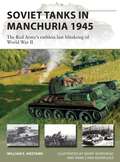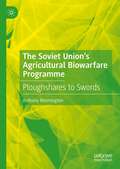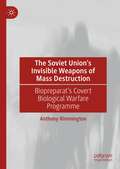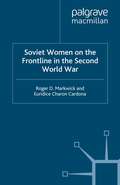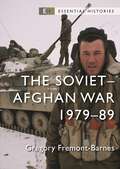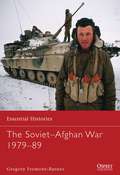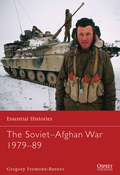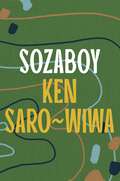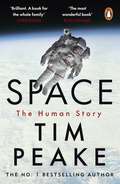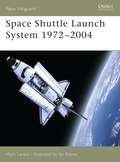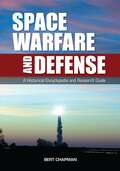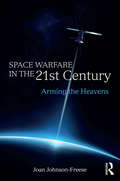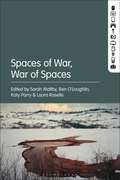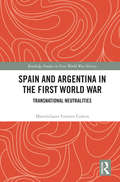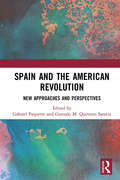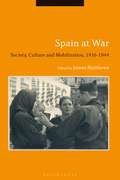- Table View
- List View
Soviet Tanks in Manchuria 1945: The Red Army's ruthless last blitzkrieg of World War II (New Vanguard)
by William E. HiestandA new illustrated study of the devastating, but little-known, Soviet armored blitzkrieg against the Japanese in the last weeks of World War II, and how it influenced Soviet tank doctrine as the Cold War dawned.Although long overshadowed in the West by the dropping of the atomic bombs on Hiroshima and Nagasaki, the USSR's lightning strike into Manchuria in August 1945 was one of the most successful and unique campaigns of the era. Soviet forces, led by over 5,500 tanks and self-propelled guns, attacked across huge distances and deserts, marshes, and mountains to smash Japan's million-strong Kwantung Army in a matter of days.Japanese forces were short of training and equipment, but nevertheless fought fiercely, inflicting 32,000 casualties on the Soviets. Red Army operations were characterized by surprise, speed, and deep penetrations by tank-heavy forces born of the brutal lessons they had learned during years fighting the Wehrmacht. Lessons from the campaign directly shaped Soviet Cold War force structure and planning for mechanized operations against the West.Illustrated with contemporary artwork and rare photos from one of the best collections of Soviet military photos in the West, this fascinating book explains exactly how the last blitzkrieg of World War II was planned, fought, and won, and how it influenced the Red Army's plans for tank warfare against NATO in Europe.
Soviet Tanks in Manchuria 1945: The Red Army's ruthless last blitzkrieg of World War II (New Vanguard #316)
by William E. HiestandA new illustrated study of the devastating, but little-known, Soviet armored blitzkrieg against the Japanese in the last weeks of World War II, and how it influenced Soviet tank doctrine as the Cold War dawned.Although long overshadowed in the West by the dropping of the atomic bombs on Hiroshima and Nagasaki, the USSR's lightning strike into Manchuria in August 1945 was one of the most successful and unique campaigns of the era. Soviet forces, led by over 5,500 tanks and self-propelled guns, attacked across huge distances and deserts, marshes, and mountains to smash Japan's million-strong Kwantung Army in a matter of days.Japanese forces were short of training and equipment, but nevertheless fought fiercely, inflicting 32,000 casualties on the Soviets. Red Army operations were characterized by surprise, speed, and deep penetrations by tank-heavy forces born of the brutal lessons they had learned during years fighting the Wehrmacht. Lessons from the campaign directly shaped Soviet Cold War force structure and planning for mechanized operations against the West.Illustrated with contemporary artwork and rare photos from one of the best collections of Soviet military photos in the West, this fascinating book explains exactly how the last blitzkrieg of World War II was planned, fought, and won, and how it influenced the Red Army's plans for tank warfare against NATO in Europe.
The Soviet Union’s Agricultural Biowarfare Programme: Ploughshares to Swords
by Anthony RimmingtonThis book focuses upon the secret agricultural biological warfare programme codenamed Ekologiya – which was pursued by the Soviet Union from 1958 through to the collapse of the USSR in 1991. It was the largest offensive agricultural biowarfare project the world has ever seen and Soviet anti-crop and anti-livestock weapons had the capability to inflict enormous damage on Western agriculture. Beginning in the early 1970s, there was a new focus within the Soviet agricultural biowarfare programme on molecular biology and the development of genetically modified agents. A key characteristic of the Ekologiya project was the creation of mobilization production facilities. These ostensibly civil manufacturing plants incorporated capacity for production of biowarfare agents in wartime emergency. During the 1990s-2000s, the counter-proliferation efforts undertaken by the US and UK played a major role in preventing the transfer of Ekologiya scientists, technologies and pathogens to Iran and other countries of potential proliferation concern.Anthony Rimmington is a former Senior Research Fellow at Birmingham University’s Centre for Russian, European and Eurasian Studies, UK. He has published widely on the civil life sciences sector in the post-Soviet states and on the Soviet Union’s offensive biological warfare programme, including Stalin’s Secret Weapon: The Origins of Soviet Biological Warfare.
The Soviet Union’s Invisible Weapons of Mass Destruction: Biopreparat's Covert Biological Warfare Programme
by Anthony RimmingtonThis book focuses on Biopreparat, the Soviet agency created in 1974, which spearheaded the largest and most sophisticated biological warfare programme the world has ever seen. At its height, Biopreparat employed more than 30,000 personnel and incorporated an enormous network embracing military-focused research institutes, design centres, biowarfare pilot facilities and dual-use production plants. The secret network pursued major offensive R&D programmes, which sought to use genetic engineering techniques to create microbial strains resistant to antibiotics and with wholly new and unexpected pathogenic properties. During the mid-1980s, Biopreparat increased in size and political importance and also emerged as a major civil biopharmaceutical player in the USSR. In the wake of the collapse of the Soviet Union in 1991, an acute struggle for control of Biopreparat’s most valuable assets took place and the network was eventually broken-up and control of its facilities transferred to a myriad of state agencies and private companies.
Soviet Women on the Frontline in the Second World War
by R. Markwick E. Charon Cardona Euridice Charon CardonaThis is the first comprehensive study in English of Soviet women who fought against the genocidal, misogynist, Nazi enemy on the Eastern Front during the Second World War. Drawing on a vast array of original archival, memoir, and published sources, this book captures the everyday experiences of Soviet women fighting, living and dying on the front.
The Soviet–Afghan War: 1979–89 (Essential Histories)
by Gregory Fremont-BarnesA fully illustrated overview of the USSR's bloody conflict in Afghanistan and its long legacy.The Soviet invasion of its neighbour Afghanistan in December 1979 sparked a nine-year conflict until Soviet forces withdrew in 1988–89, dooming the communist Afghanistan government to defeat at the hands of the mujahideen, the Afghan popular resistance backed by the USA and other powers. Gregory Fremont-Barnes reveals how the Soviet invasion had enormous implications on the global stage; it prompted the US Senate to refuse to ratify the hard-won SALT II arms-limitation treaty, and the USA and 64 other countries boycotted the 1980 Moscow Summer Olympics. For Afghanistan, the invasion served to prolong the interminable civil war that pitted central government against the regions and faction against faction. Updated and revised for the new edition, with full-colour maps and new images throughout, this succinct account explains the origins, events and consequences of the Soviet intervention in Afghanistan, shedding new light on the more recent history – and prospects – of that troubled country.
The Soviet–Afghan War: 1979–89 (Essential Histories)
by Gregory Fremont-BarnesA fully illustrated overview of the USSR's bloody conflict in Afghanistan and its long legacy.The Soviet invasion of its neighbour Afghanistan in December 1979 sparked a nine-year conflict until Soviet forces withdrew in 1988–89, dooming the communist Afghanistan government to defeat at the hands of the mujahideen, the Afghan popular resistance backed by the USA and other powers. Gregory Fremont-Barnes reveals how the Soviet invasion had enormous implications on the global stage; it prompted the US Senate to refuse to ratify the hard-won SALT II arms-limitation treaty, and the USA and 64 other countries boycotted the 1980 Moscow Summer Olympics. For Afghanistan, the invasion served to prolong the interminable civil war that pitted central government against the regions and faction against faction. Updated and revised for the new edition, with full-colour maps and new images throughout, this succinct account explains the origins, events and consequences of the Soviet intervention in Afghanistan, shedding new light on the more recent history – and prospects – of that troubled country.
The Soviet–Afghan War 1979–89 (Guide to...)
by Gregory Fremont-BarnesThe Soviet invasion of its neighbour Afghanistan in December 1979 sparked a bloody nine-year conflict in that country until Soviet forces withdrew in 1988–89, dooming the communist Afghanistan government to defeat at the hands of the Mujahideen, the Afghan popular resistance backed by the USA and other powers. The Soviet invasion had enormous implications on the global stage; it prompted the US Senate to refuse to ratify the hard-won SALT II arms-limitation treaty, and the USA and 64 other countries boycotted the 1980 Moscow Summer Olympics. For Afghanistan, the invasion served to prolong the interminable civil war that pitted central government against the regions and faction against faction. The country remains locked in conflict over 30 years later, with no end in sight. Featuring specially drawn mapping and drawing upon a wide range of sources, this succinct account explains the origins, history and consequences of the Soviet intervention in Afghanistan, thereby shedding new light on the more recent history – and prospects – of that troubled country.
The Soviet–Afghan War 1979–89 (Essential Histories)
by Gregory Fremont-BarnesThe Soviet invasion of its neighbour Afghanistan in December 1979 sparked a bloody nine-year conflict in that country until Soviet forces withdrew in 1988–89, dooming the communist Afghanistan government to defeat at the hands of the Mujahideen, the Afghan popular resistance backed by the USA and other powers. The Soviet invasion had enormous implications on the global stage; it prompted the US Senate to refuse to ratify the hard-won SALT II arms-limitation treaty, and the USA and 64 other countries boycotted the 1980 Moscow Summer Olympics. For Afghanistan, the invasion served to prolong the interminable civil war that pitted central government against the regions and faction against faction. The country remains locked in conflict over 30 years later, with no end in sight. Featuring specially drawn mapping and drawing upon a wide range of sources, this succinct account explains the origins, history and consequences of the Soviet intervention in Afghanistan, thereby shedding new light on the more recent history – and prospects – of that troubled country.
The Soviet–Afghan War 1979–89 (Essential Histories)
by Gregory Fremont-BarnesThe Soviet invasion of its neighbour Afghanistan in December 1979 sparked a bloody nine-year conflict in that country until Soviet forces withdrew in 1988–89, dooming the communist Afghanistan government to defeat at the hands of the Mujahideen, the Afghan popular resistance backed by the USA and other powers. The Soviet invasion had enormous implications on the global stage; it prompted the US Senate to refuse to ratify the hard-won SALT II arms-limitation treaty, and the USA and 64 other countries boycotted the 1980 Moscow Summer Olympics. For Afghanistan, the invasion served to prolong the interminable civil war that pitted central government against the regions and faction against faction. The country remains locked in conflict over 30 years later, with no end in sight. Featuring specially drawn mapping and drawing upon a wide range of sources, this succinct account explains the origins, history and consequences of the Soviet intervention in Afghanistan, thereby shedding new light on the more recent history – and prospects – of that troubled country.
Sozaboy
by Ken Saro-WiwaSozaboy powerfully describes the fate of a young, naive soldier thrown into the frontline of a civil war, from his first proud days of recruitment to the disillusionment and horrors that follow.Mene yearns for manhood. He dreams of gaining the glory that the ex-soldier in his village brags about, with his stories of hunting 'Hitla'. So when war breaks out and soldiers appear in Mene's isolated village, he sees his chance to finally wear a uniform. Too soon, however, Mene's innocence turns to terror. While witnessing the unfathomable, Mene must learn to evade the carnage of warfare if he wants to make it home alive...Writing in Nigerian Pidgin English, Ken Saro-Wiwa creates a unique window into the dark consequences of meaningless war.'Haunting.' Guardian 'Sozaboy is not simply a great African novel, it is also a great anti-war novel, among the very best the twentieth century has produced.' William Boyd
Space: A thrilling human history by Britain's beloved astronaut Tim Peake
by Tim PeakeFrom bestselling author and British astronaut Tim Peake, an inspirational human history of space travel, from the Apollo missions to our future forays to Mars. The Right Stuff for a new generation.'This book is brilliant - once in a blue moon. A book for the whole family.' Chris Evans, Virgin Radio'The most wonderful book ... Tim Peake is a historian and encyclopaedia of space.’ Rory Stewart'An extraordinary book. For anyone - even if you’re not interested in Space. If you’re interested in human stories and the human character - this is delightful.' BBC Breakfast'A fascinating, detailed, playful book drawn from extensive research – Peake met seven Apollo astronauts, Russian cosmonauts and various other space technicians – as well as his considerable personal experience. Lifts the lid on what space is like: the dedication and sacrifice; the politics and pantomime; the practicalities and the peril; the glory and fame; the adjustment back to normal life.' iPaper'A thrilling human history of space' Daily Mirror'The bible of space travel' Chris Moyles, Radio XAs seen in the major TV series Secrets of Our Universe with Tim Peake.Only 656 people in human history have left Earth. In Space: The Human Story, astronaut Tim Peake traces the lives of these remarkable men and women who have forged the way, from Yuri Gagarin to Neil Armstrong, from Valentina Tereshkova to Peggy Whitson.Full of exclusive new stories, and astonishing detail only an astronaut would know, the book conveys what space exploration is really like: the wondrous view of Earth, the surreal weightlessness, the extraordinary danger, the surprising humdrum, the unexpected humour, the newfound perspective, the years of training, the psychological pressures, the gruelling physical toll, the thrill of launch and the trepidation of re-entry. The book also examines the surprising, shocking and often poignant stories of astronauts back on Earth, whose lives are forever changed as they readjust to terra firma.Publication of the book comes on the eve of NASA's plans to return to the moon, fifty years after an astronaut last walked on the lunar surface. In 2024 the Artemis II mission will send four astronauts to orbit the moon. In 2025 Artemis III will send the first woman and the first person of colour to step on the lunar surface. What will separate these upcoming moonwalkers from the legendary Apollo crews? Does it still take a daring-do attitude, super-human fitness, intelligence, plus the 'Right-stuff' - a fabled grace under pressure? And how will astronauts travel even further - to Mars and beyond? Space: The Human Story reveals all.
Space Shuttle Launch System 1972–2004 (New Vanguard)
by Ian Palmer Mark LardasThe Space Shuttle is one of the oldest and most famous manned launch systems – the only launch vehicle that has been used for a longer period of time is the Soviet (now Russian) R-7 booster. By the start of the third millennium, the Space Shuttle had carried crews into space over 85 times. Although not a military structure, the Shuttle had been sold as an all-purpose launch system to be used jointly for military and civilian purposes. Featuring full-colour photos throughout, this book covers the design, development and operational history of a unique vehicle.
Space Shuttle Launch System 1972–2004 (New Vanguard #99)
by Ian Palmer Mark LardasThe Space Shuttle is one of the oldest and most famous manned launch systems – the only launch vehicle that has been used for a longer period of time is the Soviet (now Russian) R-7 booster. By the start of the third millennium, the Space Shuttle had carried crews into space over 85 times. Although not a military structure, the Shuttle had been sold as an all-purpose launch system to be used jointly for military and civilian purposes. Featuring full-colour photos throughout, this book covers the design, development and operational history of a unique vehicle.
Space Warfare and Defense: A Historical Encyclopedia and Research Guide
by Bert ChapmanThis timely resource provides a history of the development of space weapons and warfare strategies and a comprehensive reference guide to the growing literature on the subject.Space Warfare and Defense: A Historical Encyclopedia and Research Guide provides comprehensive coverage of the development of space as a possible arena for warfare, exploring the military uses of space—past, present, and future—and specific details of actual space weapons systems.The encyclopedia spans the breadth of U.S. military space policy; comparable programs in the Soviet Union, China, and the European Union; and the full array of international agreements designed to regulate the military uses of space. In addition, the encyclopedia includes an extensive reference guide (nearly 40 percent of the book) directing readers to the essential literature on space weapons and defense systems produced by the United States, other governments, research institutions, and additional sources. At a time when space is becoming an increasingly important place of military competition and potential conflict, Space Warfare and Defense dispels the myths and examines the realities of what may become humanity's ultimate battlefield.
Space Warfare in the 21st Century: Arming the Heavens (Cass Military Studies)
by Joan Johnson-FreeseThis book examines the recent shift in US space policy and the forces that continually draw the US back into a space-technology security dilemma. The dual-use nature of the vast majority of space technology, meaning of value to both civilian and military communities and being unable to differentiate offensive from defensive intent of military hardware, makes space an area particularly ripe for a security dilemma. In contrast to previous administrations, the Obama Administration has pursued a less militaristic space policy, instead employing a strategic restraint approach that stressed multilateral diplomacy to space challenges. The latter required international solutions and the United States, subsequently, even voiced support for an International Code of Conduct for Space. That policy held until the Chinese anti-satellite (ASAT) test in 2013, which demonstrated expanded Chinese capabilities. This volume explores the issues arising from evolving space capabilities across the world and the security challenges this poses. It subsequently discusses the complexity of the space environment and argues that all tools of national power must be used, with some degree of balance, toward addressing space challenges and achieving space goals. This book will be of much interest to students of space policy, defence studies, foreign policy, security studies and IR.
Space Warfare in the 21st Century: Arming the Heavens (Cass Military Studies)
by Joan Johnson-FreeseThis book examines the recent shift in US space policy and the forces that continually draw the US back into a space-technology security dilemma. The dual-use nature of the vast majority of space technology, meaning of value to both civilian and military communities and being unable to differentiate offensive from defensive intent of military hardware, makes space an area particularly ripe for a security dilemma. In contrast to previous administrations, the Obama Administration has pursued a less militaristic space policy, instead employing a strategic restraint approach that stressed multilateral diplomacy to space challenges. The latter required international solutions and the United States, subsequently, even voiced support for an International Code of Conduct for Space. That policy held until the Chinese anti-satellite (ASAT) test in 2013, which demonstrated expanded Chinese capabilities. This volume explores the issues arising from evolving space capabilities across the world and the security challenges this poses. It subsequently discusses the complexity of the space environment and argues that all tools of national power must be used, with some degree of balance, toward addressing space challenges and achieving space goals. This book will be of much interest to students of space policy, defence studies, foreign policy, security studies and IR.
Spaces of War, War of Spaces
by Laura Roselle Sarah Maltby Katy Parry Ben O’LoughlinSpaces of War, War of Spaces provides a rich, international and multi-disciplinary engagement with the convergence of war and media through the conceptual lens of 'space'. 'Space' offers a profound, challenging and original framework through which notions of communication, embodiment, enactment, memory and power are interrogated not only in terms of how media spaces (traditional, digital, cultural, aesthetic, embodied, mnemonic) transform the conduct, outcomes and consequences of war for all involved, but how 'war' actors (political, military, survivors, victims) recreate space in a manner that is transformative across political, social, cultural and personal spheres. Foregrounding the work of artists, activists and practitioners alongside more traditional scholarly approaches Spaces of War, War of Spaces engages with the 'messiness' of war and media through the convergence of practice and theory, where showing and embodying is made explicit.
Spaces of War, War of Spaces
Spaces of War, War of Spaces provides a rich, international and multi-disciplinary engagement with the convergence of war and media through the conceptual lens of 'space'. 'Space' offers a profound, challenging and original framework through which notions of communication, embodiment, enactment, memory and power are interrogated not only in terms of how media spaces (traditional, digital, cultural, aesthetic, embodied, mnemonic) transform the conduct, outcomes and consequences of war for all involved, but how 'war' actors (political, military, survivors, victims) recreate space in a manner that is transformative across political, social, cultural and personal spheres. Foregrounding the work of artists, activists and practitioners alongside more traditional scholarly approaches Spaces of War, War of Spaces engages with the 'messiness' of war and media through the convergence of practice and theory, where showing and embodying is made explicit.
Spain 1936: Year Zero (Liverpool Studies in Spanish History)
by Raanan Rein Joan ThomasMarking the 80th anniversary of the outbreak of the Spanish Civil War, this volume takes a close look at the initial political moves, military actions and consequences of the fratricidal conflict and their impact on both Spaniards and contemporary European powers. The contributors re-examine the crystallization of the political alliances formed in the Republican and the Nationalist zones; the support mobilized by the two warring camps; and the different attitudes and policies adopted by neighbouring and far away countries. Spain 1936: Year Zero goes beyond and against commonly held assumptions as to the supposed unity of the Nationalist camp vis-a-vis the fragmentation of the Republican one; and likewise brings to the fore the complexities of initial support of the military rebellion by Nazi Germany and Soviet support of the beleaguered Republic. Situating the Iberian conflict in the larger international context, senior and junior scholars from various countries challenge the multitude of hitherto accepted ideas about the beginnings of the Spanish Civil War. A primary aim of the editors is to enable discussion on the Spanish Civil War from lesser known or realized perspectives by investigating the civil wars impact on countries such as Argentina, Japan, and Jewish Palestine; and from lesser heard voices at the time of women, intellectuals, and athletes. Original contributions are devoted to the Popular Olympiad organized in Barcelona in July 1936, Japanese perceptions of the Spanish conflict in light of the 1931 invasion to Manchuria, and international volunteers in the International Brigades.
Spain and Argentina in the First World War: Transnational Neutralities (Routledge Studies in First World War History)
by Maximiliano Fuentes CoderaThis is the first book that analyzes the transnational impact of the Great War simultaneously on two countries, Spain and Argentina, that remained neutral throughout the conflict. Both countries were very relevant in the conception of propaganda and policies of belligerent countries such as France, Germany and Great Britain and showed that the conflict had a global influence and affected deeply local political and cultural processes, even in areas geographically distant from the trenches. Within this framework, this book is focused on three aspects that are analyzed dynamically throughout the whole war from a transnational perspective: neutrality as a space of dispute between pro-Allies and pro-German sectors and its relation with local politics, the debate about what positions should be assumed in order to guarantee a world without war, and the polemics on the ideas of nations and supra-nations (Hispanism, Latinism, Pan-Americanism). The conclusions of the book highlight that the radicalization that exploded in 1917 in both countries was fundamental in shaping the political radicalization of the last months of the conflict and the postwar period. As happened in Europe, the Great War did not finish in 1918 and its traces continued in the 1920s and 1930s.
Spain and Argentina in the First World War: Transnational Neutralities (Routledge Studies in First World War History)
by Maximiliano Fuentes CoderaThis is the first book that analyzes the transnational impact of the Great War simultaneously on two countries, Spain and Argentina, that remained neutral throughout the conflict. Both countries were very relevant in the conception of propaganda and policies of belligerent countries such as France, Germany and Great Britain and showed that the conflict had a global influence and affected deeply local political and cultural processes, even in areas geographically distant from the trenches. Within this framework, this book is focused on three aspects that are analyzed dynamically throughout the whole war from a transnational perspective: neutrality as a space of dispute between pro-Allies and pro-German sectors and its relation with local politics, the debate about what positions should be assumed in order to guarantee a world without war, and the polemics on the ideas of nations and supra-nations (Hispanism, Latinism, Pan-Americanism). The conclusions of the book highlight that the radicalization that exploded in 1917 in both countries was fundamental in shaping the political radicalization of the last months of the conflict and the postwar period. As happened in Europe, the Great War did not finish in 1918 and its traces continued in the 1920s and 1930s.
Spain and the American Revolution: New Approaches and Perspectives
by Gabriel Paquette Gonzalo M. Quintero SaraviaThough the participation of France in the American Revolution is well established in the historiography, the role of Spain, France’s ally, is relatively understudied and underappreciated. Spain's involvement in the conflict formed part of a global struggle between empires and directly influenced the outcome of the clash between Britain and its North American colonists. Following the establishment of American independence, the Spanish empire became one of the nascent republic's most significant neighbors and, often illicitly, trading partners. Bringing together essays from a range of well-regarded historians, this volume contributes significantly to the international history of the Age of Atlantic Revolutions.
Spain and the American Revolution: New Approaches and Perspectives
by Gabriel Paquette Gonzalo M. Quintero SaraviaThough the participation of France in the American Revolution is well established in the historiography, the role of Spain, France’s ally, is relatively understudied and underappreciated. Spain's involvement in the conflict formed part of a global struggle between empires and directly influenced the outcome of the clash between Britain and its North American colonists. Following the establishment of American independence, the Spanish empire became one of the nascent republic's most significant neighbors and, often illicitly, trading partners. Bringing together essays from a range of well-regarded historians, this volume contributes significantly to the international history of the Age of Atlantic Revolutions.
Spain at War: Society, Culture and Mobilization, 1936-44
by James MatthewsSpain's principal and most devastating war during the 20th century was, unusually for most of Europe, an internal conflict. During the Spanish Civil War of 1936 to 1939 two competing armies – the insurgent and counterrevolutionary Nationalist Army and the Republican Popular Army – engaged in a conflict to impose their version of Spanish identity and the right to shape the country's future. In its aftermath, Francoist Spain remained on a war footing for the duration of the Second World War. In spite of the unabated flood of books on the Spanish Civil War and its consequences, historians of Spain in the 20th century have focused relatively little on the interaction of society and culture, and their roles in wartime mobilization. Spain at War addresses this omission through an examination of individual experiences of conflict and the mobilization of society. This edited volume acknowledges the agency of low-ranking individuals and the impact of their choices upon the historical processes that shaped the conflict and its aftermath. In doing so, this new military history provides a more complex and nuanced understanding of Spain's most intense period of wartime cultural mobilization between the years 1936 to 1944 and challenges traditional political accounts of the period.
